Creating an inviting outdoor space that works for your lifestyle starts with smart planning. Whether you’re growing herbs on a patio or nurturing flowers in a large yard, strategic designs help you balance beauty with practicality. The secret lies in matching your personal vision to the natural flow of your environment.
Even compact areas can become multi-functional retreats when organized thoughtfully. Imagine separating your gardening spots into cozy corners for relaxation, lively areas for gatherings, and productive sections for fresh produce. These adaptable layouts evolve with the seasons, keeping your space useful year-round.
You don’t need professional expertise to achieve stunning results. Simple patterns like geometric beds or vertical planters make maintenance easier while maximizing growth potential. Proper spacing between features ensures every inch serves a purpose, from winding pathways to sunlit reading nooks.
The best part? These design principles work equally well in dry climates and humid regions. With clever material choices and plant selection, your outdoor space becomes an extension of your home’s living area. Ready to reimagine what your backyard can become?
Embracing Creative Garden Layouts
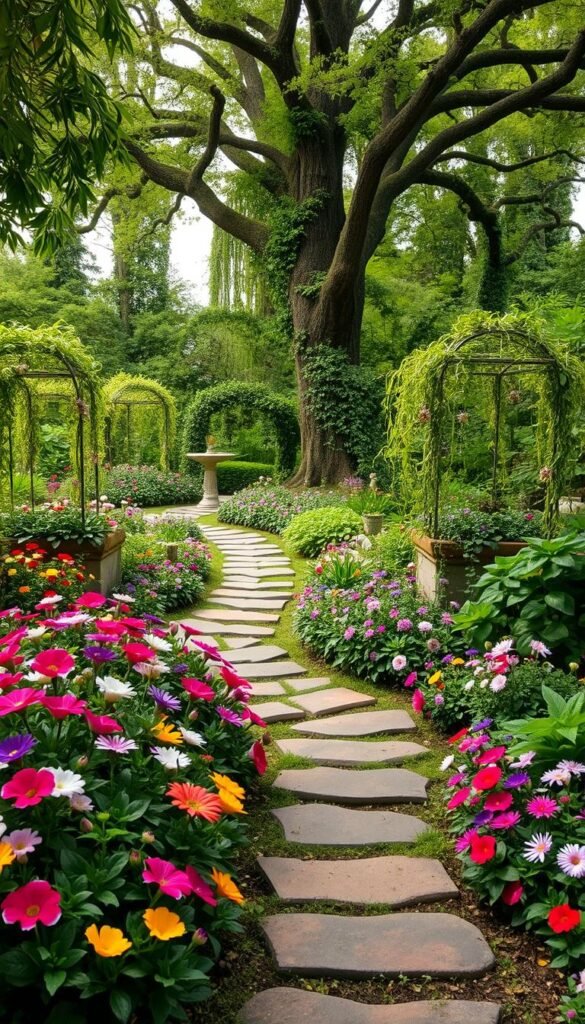
Your outdoor area becomes a canvas when you explore dynamic arrangement strategies. By mixing textures, colors, and functional zones, you craft spaces that grow with your life. Garden layouts act like fingerprints – no two need to be identical, yet each reveals your priorities.
| Layout Style | Key Benefit | Ideal For |
|---|---|---|
| Zoned Designs | Creates separate activity areas | Multi-use spaces |
| Vertical Solutions | Saves ground space | Small patios |
| Curved Patterns | Softens rigid lines | Natural landscapes |
“The magic happens when seating nooks whisper to vegetable patches,” observes a landscape designer. This philosophy helps merge relaxation spots with productive areas without visual clutter.
Smart designs account for sun patterns and foot traffic. A reading corner might thrive under dappled shade, while herb planters demand full sunlight. Rotate seasonal blooms near gathering spaces to maintain year-round appeal.
Designing with Raised Beds and Grid Patterns
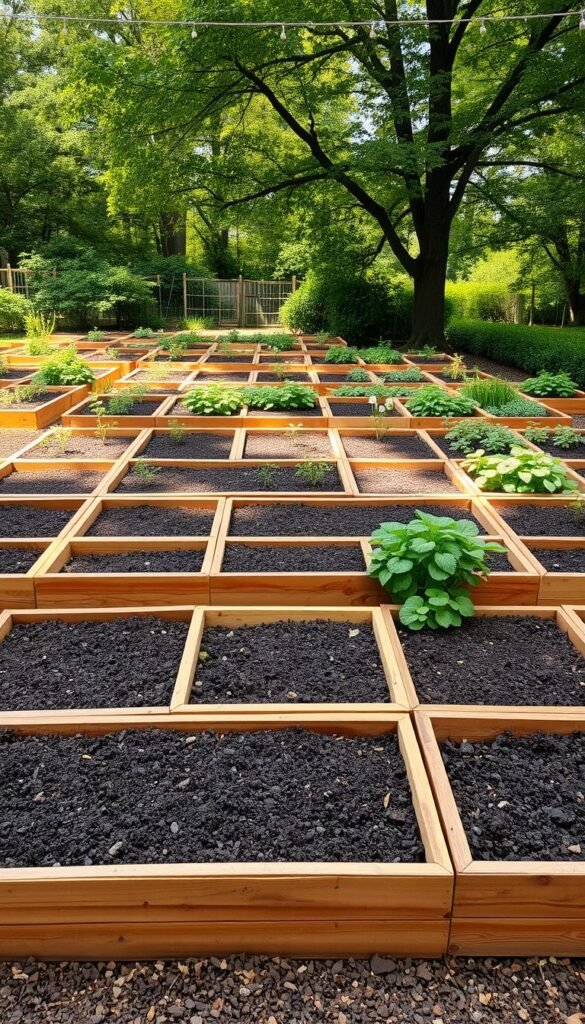
Elevate your planting strategy with raised beds arranged in crisp grid formations. This approach transforms cramped corners into thriving zones where vegetables and flowers flourish. Unlike traditional rows, grids let you manage soil quality precisely while keeping pathways clear for easy access.
Four-foot-wide beds strike the perfect balance—narrow enough to reach plants without stepping on soil. Pair them with gravel or mulch paths to prevent mud during rainy seasons. Gardeners love how this layout reduces weeds and simplifies crop rotations. “Grids turn chaos into order,” notes a home grower from Oregon.
| Feature | Benefit | Best Use |
|---|---|---|
| Custom Soil Mix | Boosts plant health | Clay or sandy areas |
| Narrow Pathways | Saves ground space | Urban backyards |
| Elevated Design | Warms soil faster | Cool climates |
| Adjustable Heights | Eases back strain | Accessible gardening |
| Modular Grids | Simplifies rotations | Year-round crops |
Install drip irrigation lines before filling beds to conserve water. For more inspiration, explore these vegetable garden layouts that complement grid designs. You’ll appreciate how structured beds make fertilizing and harvesting feel effortless.
Tailor your grid to match sunlight patterns—place heat-loving tomatoes in sunnier sections and leafy greens in partial shade. This method adapts to any yard size, proving that smart design beats raw square footage every time.
Exploring Potager and Kitchen Garden Concepts
Transform your backyard into a living pantry with a potager garden – where practicality meets artistry. This French-inspired approach arranges herbs, vegetables, and flowers in geometric patterns that delight the eye while feeding your table. Imagine plucking basil for tonight’s pasta just steps from your kitchen door.
Start by outlining symmetrical beds with crisp edges, using materials like brick or low hedges. Intersperse rainbow chard with marigolds – their vibrant hues create edible landscapes, while companion plants like nasturtiums naturally deter pests. Clear gravel pathways let you harvest greens without muddying your shoes.
What makes these spaces special? They evolve weekly. Sow quick-growing radishes between slower cabbage plants, then replace them with fall kale. “A potager isn’t static – it’s a choreographed dance of color and flavor,” shares a Texas-based garden designer. This constant renewal ensures fresh ingredients for every season.
Your kitchen garden becomes both canvas and grocery store. Train scarlet runner beans up obelisks beside purple basil, creating vertical interest. Tuck fragrant thyme along path edges where footsteps release its aroma. With smart planning, even a 10’x10’ plot yields surprising abundance while looking magazine-ready.
Implementing Circular and Mandala Garden Patterns
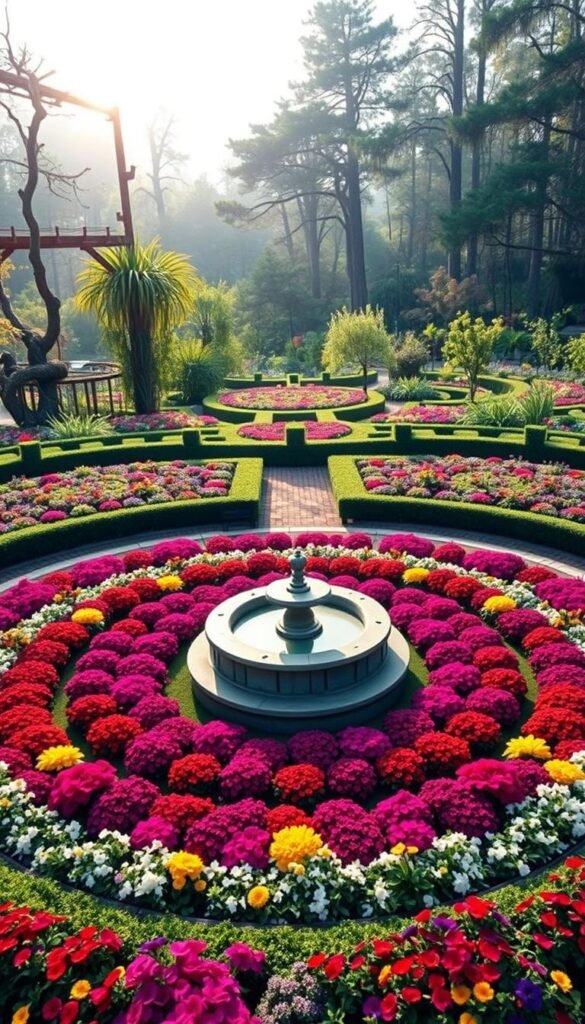
Unlock the power of curved design by crafting spaces that pull your gaze toward captivating focal points. Start with a central element—a bubbling stone basin or towering sunflower cluster works wonders. Arrange your plants in radiating circles, using taller varieties near the center and trailing types along the edges.
Mandala patterns take this concept further, blending ancient geometry with modern practicality. “These living artworks guide both the eye and the gardener’s footsteps,” explains a Colorado-based landscape artist. Interlocking pathways divide the space into pie-shaped sections, making weeding and harvesting feel like a meditative practice.
| Feature | Benefit | Best Use |
|---|---|---|
| Central Sculpture | Creates visual anchor | Meditation zones |
| Herb Rings | Easy harvesting access | Culinary spaces |
| Spiral Pathways | Enhances exploration | Larger yards |
Stepping stones between planting zones keep your feet dry while adding rustic charm. This layout shines in herb gardens, where thyme and lavender can form fragrant borders. For evening enjoyment, position solar lights along the pathways to highlight your circular masterpiece.
Maintenance becomes simpler when each wedge serves a purpose—dedicate sections to seasonal blooms, veggies, or ground covers. The pattern naturally deters pests by mixing plant types, while the circular flow helps rainwater reach every root. Your outdoor sanctuary now whispers invitations to pause and admire nature’s perfect shapes.
Optimizing Vertical Garden Solutions
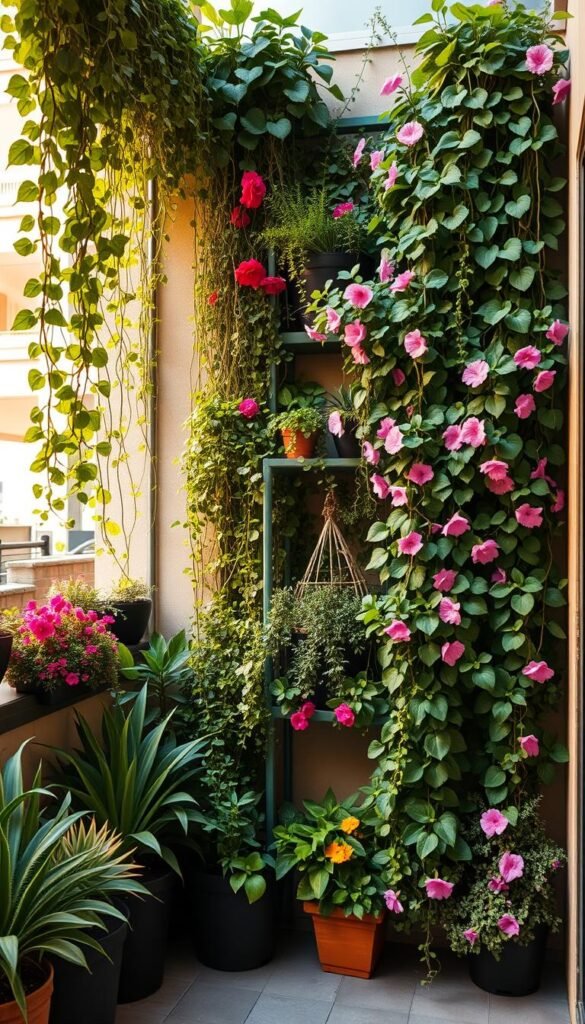
Vertical surfaces become your secret weapon in small-space gardening. By directing growth upward, you multiply planting areas without expanding your footprint. Walls and trellises transform into thriving ecosystems where strawberries cascade and morning glories climb toward the sun.
Urban dwellers particularly benefit from these techniques. A balcony rail supporting pea vines or a fire escape adorned with herb pockets turns concrete jungles into edible landscapes. “Vertical systems let me grow three times more food in my Brooklyn studio,” shares apartment gardener Mia Chen.
| System Type | Best Plants | Space Needed |
|---|---|---|
| Pocket Planters | Herbs & Succulents | 12″ depth |
| Trellis Grids | Cucumbers & Beans | Wall surface |
| Tiered Towers | Leafy Greens | 3′ diameter |
Mix practical and ornamental species for dual-purpose displays. Flowering nasturtiums add color while repelling pests from your tomatoes. Maintain accessibility by positioning frequently harvested items at eye level, saving your knees from constant bending.
These solutions prove that limited square footage doesn’t mean compromising on variety or yield. Your vertical oasis becomes a living tapestry that nourishes both body and soul.
Crafting a Keyhole Garden for Efficiency

Revolutionize your growing space with a keyhole structure that feeds itself. These circular raised beds feature a central compost basket shaped like a lock’s opening – hence the name. As kitchen scraps break down, they release nutrients directly into the surrounding soil, creating a closed-loop system that keeps your plants thriving.
The design slashes water needs dramatically. “My keyhole setup uses 80% less irrigation than traditional rows,” shares a gardener from Arizona. Moisture stays locked in thanks to the raised walls and compost core, while excess drains freely through layered stones or gravel.
| Feature | Benefit | Best For |
|---|---|---|
| Central Compost | Continuous nutrition | Vegetable patches |
| Notched Access | Easy maintenance | Small areas |
| Raised Structure | Better drainage | Wet climates |
Build yours using materials you already have – stacked bricks, salvaged lumber, or even wine bottles. The circular shape maximizes planting space while the notch lets you reach every corner without stepping on beds. Pair this system with square foot gardening principles for ultra-efficient yields.
Pro tip: Layer cardboard at the base before adding soil. It suppresses weeds while decomposing into organic matter over time. Your keyhole garden becomes a living ecosystem where waste transforms into bounty.
10 Garden Layout Ideas to Organize Your Outdoor Space Efficiently

Discover how seasoned growers maximize their plots using battle-tested arrangements. Real-world examples show that smart vegetable garden designs boost yields while simplifying maintenance. From urban balconies to sprawling backyards, these strategies adapt to your unique growing conditions.
One popular approach arranges plants in staggered rows with alternating heights. This lets sunlight reach every leaf while creating natural windbreaks. “Interplanting tall corn with low-growing squash mimics nature’s layering,” explains a Michigan gardener. Such techniques prevent soil exhaustion and pest buildup.
| Layout Style | Productivity Boost | Space Savings |
|---|---|---|
| Companion Grids | 30% more yield | Compact areas |
| L-Shaped Beds | Easy crop rotation | Corner spaces |
| Hexagonal Planting | 15% denser growth | Medium plots |
New England growers swear by cold frame extensions that stretch the growing season. These glass-topped boxes protect early seedlings and fall crops from frost. Pair them with vertical trellises for climbing beans to maximize your outdoor space.
Your garden layout becomes a living laboratory. Test different arrangements each season – maybe basil thrives better near tomatoes than peppers. Document what works in your microclimate through simple sketches or garden apps.
Maximizing Yield with Square Foot Gardening

Turn limited ground space into a powerhouse of fresh produce using grid-based precision. Square foot gardening revolutionizes small plots by transforming beds into neatly divided planting zones. Each 1×1-foot square becomes its own micro-environment, letting you grow diverse crops without overcrowding.
Planning Your 1-Foot Grid
Start with a 4×4-foot frame filled with nutrient-rich soil. Lay a lattice grid across the top to create visible boundaries for each section. This system eliminates guesswork – plant one type of vegetable per square based on its mature size. For example:
| Plant Type | Per Square | Harvest Timeline |
|---|---|---|
| Leafy Greens | 9 plants | 3-4 weeks |
| Tomatoes | 1 plant | 8-10 weeks |
| Carrots | 16 plants | 7-9 weeks |
This method makes harvesting simpler since you’re managing small, organized sections rather than sprawling rows. “My grid acts like a planting calendar – I always know what’s ready next,” shares a home gardener from Utah.
Sustainable Crop Rotation Techniques
Keep your soil thriving by rotating plant families through different squares each season. Follow heavy feeders like tomatoes with nitrogen-fixing peas or beans. This natural approach prevents nutrient depletion while disrupting pest cycles.
Pair your grid with a square foot gardening layout that groups compatible plants. Basil thrives near peppers, while radishes protect cucumbers from beetles. You’ll enjoy continuous harvests while maintaining soil health – no chemicals required.
Creating Herb Spirals and Multi-Level Garden Designs
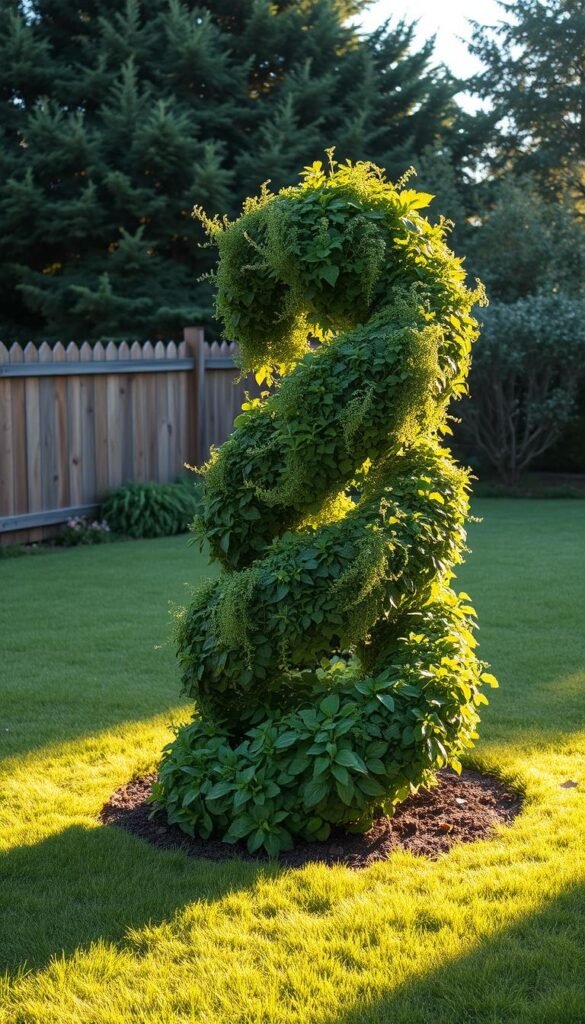
Transform flat planting areas into thriving three-dimensional ecosystems using clever elevation techniques. A well-planned herb spiral becomes both a culinary resource and sculptural focal point, blending practicality with natural beauty. This approach lets you grow diverse plants in tight spaces while enhancing soil health.
Designing the Perfect Herb Spiral
Start by stacking stones or bricks into a 5-foot-wide spiral rising 2-3 feet tall. The coiled shape creates four distinct microclimates: shady and moist at the base, sunny and dry at the peak. “This design mimics how plants grow in nature—no two spots have identical conditions,” notes a permaculture expert from California.
| Herb | Spiral Position | Benefit |
|---|---|---|
| Mint | North-facing base | Prefers cool shade |
| Parsley | Eastern mid-level | Morning sun lover |
| Thyme | Southwest slope | Thrives in dry heat |
| Rosemary | Sunny summit | Needs sharp drainage |
Layering for Visual Interest and Function
Elevation changes do more than save space—they create living art. Cascading oregano softens stone edges while upright lavender adds vertical structure. These tiers make harvesting easier by bringing plants to waist height.
Pair your spiral with companion flowers like calendula to attract pollinators. The layered design naturally deters pests through strategic plant placement. You’ll enjoy fresh flavors at your fingertips while turning a basic corner into a conversation piece.
Developing Woodland Edge and Permaculture Zone Gardens
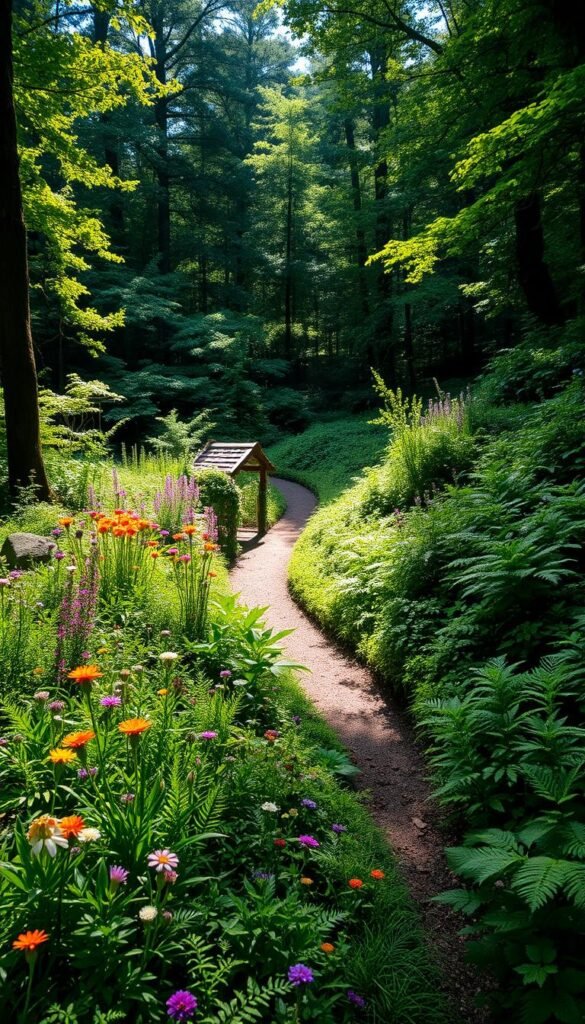
Blend nature’s blueprint with practical cultivation by shaping spaces that mirror forest edges. These gardens transition smoothly from towering trees to berry bushes, then to ground-level vegetables, creating a self-sustaining ecosystem. You’ll work with existing soil conditions rather than fighting them, saving time and resources.
Start by observing how sunlight filters through existing trees. Plant shade-loving ramps and mushrooms beneath the canopy, then add currant bushes in dappled light areas. Finish with native violets and ferns along the perimeter. “This layered approach feeds wildlife while feeding your family,” notes a permaculture designer from Vermont.
| Feature | Benefit | Best Plants |
|---|---|---|
| Canopy Layer | Natural shade control | Oak, Maple |
| Shrub Layer | Wind protection | Blueberry, Hazel |
| Ground Layer | Moisture retention | Hostas, Ramps |
Permaculture zoning simplifies maintenance by grouping plants based on care needs. Place daily-harvest herbs near your back door, while low-effort fruit trees occupy outer zones. This layout respects your time while maximizing productivity.
These naturalistic gardens thrive in varied conditions, from moist clay soils to rocky slopes. They attract pollinators and pest-eating birds, creating balanced growing environments. Your once-overlooked tree line becomes a thriving habitat that yields food and beauty with minimal effort.
Incorporating Terraces and Retaining Walls
Sloped landscapes offer untapped potential when shaped with thoughtful earthworks. Terraced platforms turn steep inclines into productive growing zones while preventing soil erosion. These layered structures create flat planting areas perfect for herbs, flowers, or vegetables.
Benefits of Terracing in Sloped Areas
Terracing maximizes usable space by converting tricky slopes into cascading gardens. Wide steps between levels provide safe access for watering and harvesting. Studies show these designs reduce runoff by 75% while boosting planting area by 40% in sloped yards.
Choosing the Right Retaining Wall Materials
Select materials that complement your landscape’s style and function. Natural stone blends seamlessly with rustic settings, while modular concrete blocks suit modern aesthetics. For a cozy touch, add seating nooks into wall designs using flat-topped stones or weather-resistant timber.
Edge each terrace with trailing plants like creeping thyme to soften walls and attract pollinators. Incorporate creative designs such as spiral staircases or integrated planters to elevate both form and function. Your transformed slope becomes a thriving, multi-level retreat that works as hard as it looks beautiful.






